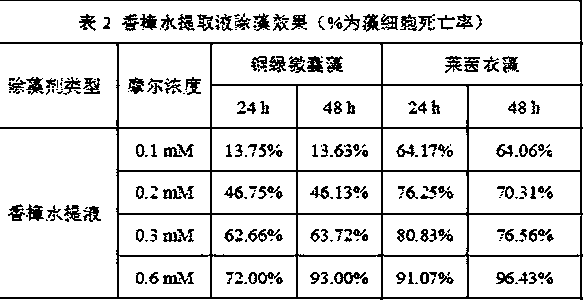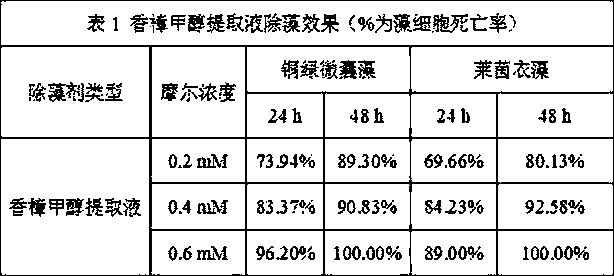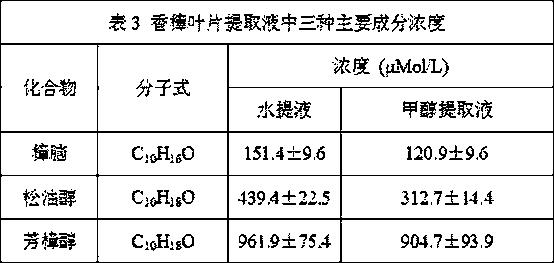Cinnamomum camphora-based biological algaecides and preparation methods thereof
A technology of algaecide and camphor, which is applied in the field of algaecide and environmental protection, can solve the problems of destroying the ecological environment, water pollution, poisoning aquatic organisms, etc., and achieve the effects of simple procurement, fast preparation process and convenient storage
- Summary
- Abstract
- Description
- Claims
- Application Information
AI Technical Summary
Problems solved by technology
Method used
Image
Examples
Embodiment 1
[0021] The preparation method of described camphor methanol extract comprises the following steps:
[0022] (1) Clean and dry the camphor leaves, and grind the dried camphor leaves into powder;
[0023] (2) Add the obtained Cinnamomum camphora leaf powder into the methanol solution, and extract at room temperature and in the dark for 36-48 hours to obtain a Cinnamomum camphora methanol extract with an extract concentration of 4-5 mM.
[0024] In this example, according to the types of the main harmful algae cyanobacteria and green algae, the typical species of cyanobacteria blooms, Microcystis aeruginosa, and Chlamydomonas reinhardtii, a typical species of green algae, were respectively selected to carry out algae removal experiments. In the Chlamydomonas reinhardtii cell solution, apply different molar concentrations of camphor methanol extract, and record its algae removal effect in two time periods of 24h and 48h, see Table 1;
[0025]
[0026] It can be seen from Table...
Embodiment 2
[0028] The preparation method of described Cinnamomum camphora water extract comprises the following steps:
[0029] (a) clean the leaves of camphor camphor, dry them, and grind the dried leaves of camphor camphor into powder;
[0030] (b) Add the obtained Cinnamomum camphora leaf powder into pure water, and extract at room temperature and in the dark for 36-48 hours to obtain a Cinnamomum camphora water extract with an extract concentration of 1.5-2.5 mM.
[0031] In this example, according to the types of the existing main harmful algae cyanobacteria and green algae, the typical algal species of cyanobacteria blooms, Microcystis aeruginosa, and the typical algal species of green algae, Chlamydomonas reinhardtii, were selected to carry out algae removal experiments. Solution and Chlamydomonas reinhardtii cell solution, apply the camphor water extract of different molar concentrations, record its algae removal effect in two time periods of 24h and 48h, see Table 2;
[0032] ...
Embodiment 3
[0036] In this embodiment, the algae removal effect of camphor leaves is analyzed by GC-MS for its main components. The contents of camphor, terpineol and linalool are relatively high, which are the main components of the water extract and methanol extract of camphor leaves. Components, the molar concentration ratio is about 1:2.6~2.9:6.3~7.5, see Table 3;
[0037]
[0038] In this example, a mixed algae-removing solution is prepared according to the concentration ratios of the three main components in the camphor leaf extract (see Table 3), wherein the preparation method of the mixed algae-removing solution includes the following steps:
[0039] (A) Take camphor, terpineol, and linalool, add them to ethanol respectively, and mix them at a molar ratio of 1:2.6~2.9:6.3~7.5 to obtain the mixed algae removal solution. The concentration is 100 mM.
[0040] Camphor, terpineol, and linalool can be purchased or extracted from camphor leaves.
[0041] In this example, according t...
PUM
 Login to View More
Login to View More Abstract
Description
Claims
Application Information
 Login to View More
Login to View More - R&D
- Intellectual Property
- Life Sciences
- Materials
- Tech Scout
- Unparalleled Data Quality
- Higher Quality Content
- 60% Fewer Hallucinations
Browse by: Latest US Patents, China's latest patents, Technical Efficacy Thesaurus, Application Domain, Technology Topic, Popular Technical Reports.
© 2025 PatSnap. All rights reserved.Legal|Privacy policy|Modern Slavery Act Transparency Statement|Sitemap|About US| Contact US: help@patsnap.com



